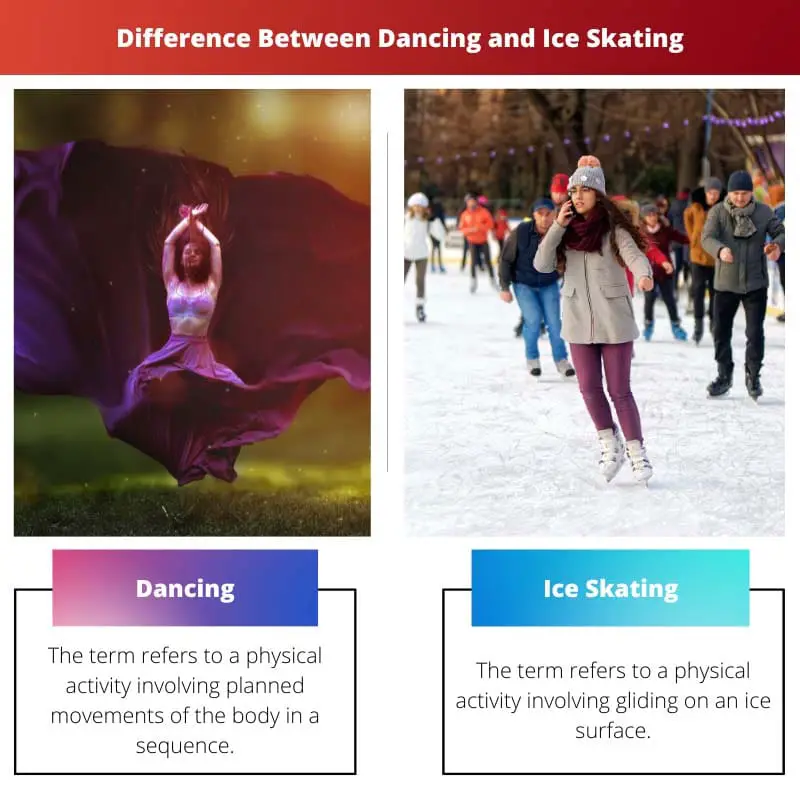Physical activities have always been a great way for human civilization to achieve new heights of experiences, and among all these activities, two prominent ones are Dancing and Ice Skating, which are performed all across the world.
While these two activities are very different from one another, these might lead to confusion if not understood properly.
Key Takeaways
- Dancing encompasses various styles and techniques performed on solid ground, while ice skating involves gliding and performing moves on the ice.
- Ice skating requires specialized equipment, such as skates and appropriate attire, whereas dancing requires less equipment.
- Both activities combine athleticism and artistic expression, but ice skating presents unique challenges and risks due to the slippery surface.
Dancing vs Ice Skating
Dancing means moving the body, including the arms, legs, and torso, rhythmically to follow music. This can occur on various surfaces, such as a stage or a dance floor. Ice skating involves gliding across ice surfaces while performing movements such as spins, jumps, and turns.

The term dancing basically represents a very popular practice all across the globe that encompasses certain individuals moving their bodies in a particularly given sequence known as choreography.
This activity has a wide variety of different types belonging to different countries and ethnicities. However, essentially it amounts to a rhythmic movement on a particular sound.
But on the other hand, Ice Skating is somehow similar to dancing in terms of movement but entails a completely different type of activity practiced by many people all across the world.
It simply refers to a process that entails certain individuals sliding on a surface built of ice with the use of particular equipment known as skates.
Comparison Table
| Parameters of Comparison | Dancing | Ice Skating |
|---|---|---|
| Meaning | The term refers to a physical activity involving planned movements of the body in a sequence. | The term refers to a physical activity involving gliding on an ice surface. |
| Sequence of movement | The movements are synchronized based on a particular musical tone. | The movements can be random but balanced in order to keep moving on the ice. |
| Things required | Usually, the only thing required for this particular activity is music. | Usually, this activity requires an ice surface along with certain other equipment. |
| Methodology used | A particular methodology used in this activity is known as choreography. | No such methodology is used. |
| Historical origin | Rock shelters at Bhimbetka and some Egyptian tombs have been known to first have the engravings of dancing sequences. | As per the reports, Finland is known to have first started this particular practice. |
What is Dancing?
Dancing is a very ancient and popular practice all across the globe, and different cultures and ethnicities practice this activity in a certain manner according to their historical values and other preferences.
In simple words, dancing refers to a physical activity that is performed by an individual by moving this body in a specific sequence on a given musical note or tone.
Usually, the patterns of dancing depend upon different musical preferences by people belonging to different cultures, and this is the major phenomenon that affects and differentiates between different forms of dance.
As per historical evidence, Rock shelters at Bhimbetka in India and some Egyptian tombs have been known to first have the engravings of dancing sequences, and it is concluded that dancing was practiced in these parts of the world in the very initial days of human civilization.
However, apart from being just a physical activity, dance also represents the thoughts and behaviors of people practicing it.
Another very essential component of dance is music, as in most cases, dance is performed on a particular rhythm or musical sound, and depending upon different types of sounds, forms of dance also differ.

What is Ice Skating?
Ice skating as a physical activity holds utter importance in many countries as it essentially signifies their inclination towards various forms of physical exercise involving the element of ice.
Ice skating can easily be defined as an activity that involves a particular individual or a group of many individuals sliding on a piece of ice with the help of particular equipment known as ice skates.
In most cases, these ice skates are built of metal in order to prevent ice from being damaged.
However, these skates also help the person in gliding and provide the body of the person a specific kind of movement, which allows him to glide on that piece of ice.
Depending upon the preference of the individual practicing this activity, it can be performed as an outdoor sport by using natural water bodies, or it can be performed as an indoor sport by building artificial ice surfaces.
As per historical reports, it has been suggested that for the first time, this activity was performed in Finland in the 19th century, and the reason behind the emergence of this particular activity was the urge of individuals to travel on ice using certain specific equipment that soon turned into a sport.

Main Differences Between Dancing and Ice Skating
- Dancing is a physical activity involving planned movements of the body in a sequence, while on the other hand, Ice Skating physical activity involves gliding on an ice surface.
- Dancing consists of synchronized movements on a musical tone, while on the other hand, Ice Skating consists of gliding on an ice surface.
- Dancing was first found as historical evidence at the Rock shelters of Bhimbetka, while on the other hand, Ice Skating was first found as historical evidence in Finland.
- Dancing requires a particular methodology known as choreography, while on the other hand, Ice Skating does not require any such practice.
- Dancing does not require any specific equipment, while on the other hand, Ice Skating requires an ice surface along with some ice skates.

References
- https://link.springer.com/content/pdf/10.1057/9780230626485.pdf
- https://aapt.scitation.org/doi/abs/10.1119/1.18028
